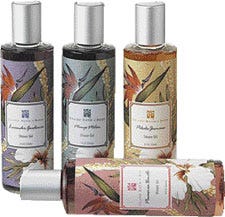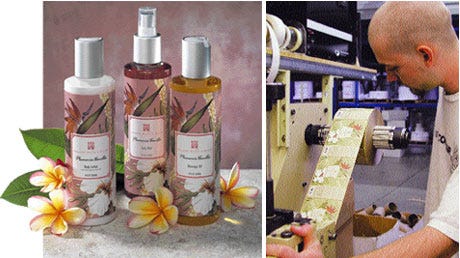January 29, 2014
|
Seven-color labels are printed on Paragon's narrow-web flexo presses on a PP stock. |
Twenty years ago, the New York Times interviewed Jason Grossman, vp of production for decorative-sticker producer Mrs. Grossman's Paper Co., Petaluma, CA, about the then-burgeoning scrapbook craze and the printed sticker business. "What will you do if sticker sales ever slow down?" the reporter asked. "Off the cuff, I just said, print wine labels," Grossman recalls. And Paragon Label was born.
Of course, it wasn't really that simple. Four-year-old Paragon sprang from a fortuitous investment by Mrs. Grossman's in two new flexo presses, purchased for a particularly large sticker customer that only needed the converter's services for one year. "When I bought those presses, I knew it was just to get that year's orders out," Grossman recalls, "then, we'd either sell them, mothball them or start the label company."
After a year of structuring the label-converting business, Paragon hit the road running, "at least doubling" its sales each year since, says Grossman. Today Paragon serves about 400 label customers, 90 percent of which are in the wine industry–a natural, given the converter's prime location north of San Francisco. The balance is represented by food, cosmetics, and heath and beauty aids packagers, an area that Paragon hopes to expand.
Typifying Paragon's skill with graphically complex, flexo-printed label designs is one recent project in particular: a line of HBA products from Honolulu, HI-based Island Bath & Body™, a Div. of The Madden Corp. Previously printed by offset on paper label stock, the Island Bath & Body labels now boast a beauty and consistency never achieved before.
Sticking to labels
Founded in 1979 by Jason Grossman's mother, Andrea, Mrs. Grossman's Paper Co. is the country's largest sticker manufacturer, printing more than 15,000 miles of pressure-sensitive stickers a year in more than 600 different designs. Paragon occupies about one-fifth of Mrs. Grossman's 110,000-sq-ft, two-story plant, which overlooks the tranquil Petaluma River. Sharing other resources as well, Paragon utilizes the skills of 10 of Mrs. Grossman's employees, in addition to its own full-time staff of 17.
Admits Grossman, "We weren't a serious label company at first. The first year was spent futzing around a lot, but we've grown tremendously since then." A big boost to Paragon's growth was its purchase of local rival McCoy Packaging, an 80-year-old flexo label converter, in December 2002. Along with McCoy came British-born general manager Gary Cane. A 30-year veteran of the printing industry, Cane brought with him some much-needed expertise in how a label-making operation should be run.
|
Because the labels graphics are now uniform in color from one sku to another, Paragon can print any of the items on any one of its 10 narrow-web presses. |
The purchase of McCoy also provided Paragon with some techniques and methods that previously were outsourced. One important piece of equipment brought from McCoy was an off-line Iwasaki TR25 hot-stamp and embossing press with an in-line UV-varnisher from Pactek Intl. "We had an off-line foiling system," Grossman says, "but nothing can compare to the Iwasaki. That allowed us to go after customers we couldn't otherwise approach. It cut costs, and it runs faster."
At present, Paragon's goal is to level out its wine-label business, "splitting that in half," Grossman says. "HBA is fairly new for us, and we're interested in gourmet foods. Those markets are a perfect fit for us; they're just like wineries."
One advantage HBA and food have over wine, however, is that these markets are not as seasonal, explains Cane. "We're trying to be more diversified for when the wine season stops," he says, "so we can keep the presses rolling and keep things going."
HBA challenge
Last year, Island Bath & Body approached Paragon about producing its range of bath and body product labels. The company sells its tropical-inspired spa items in Pacific Island stores, including Wal-Mart and ABC Stores, carrying souvenir and gift items, as well as through its catalog and its website. Shower gels, body mists and lotions, massage oils, cologne and more are divided up into four fragrances–Lavender Gardenia, Mango Melon, Pikake Jasmine and Plumeria Vanilla.
While the label's subtly colored graphics, depicting illustrations of the graceful Hawaiian flowers for which the products are named, remain the same for each variety, the background colors behind the graphics change depending upon the fragrance. The Mango line has a teal background, Lavender Gardenia is lavender, Plumeria is rose and Pikake is beige.
Originally, Island Bath & Body sourced the labels from a converter in China that offset-printed them on a paper label stock. "But there were huge inconsistencies in the color," notes Karen Bertolini, sales rep for Paragon. "Island Bath & Body would unwrap one wind on a roll, and they would have different colors in a wrap."
Despite this, Cane recalls that the company was somewhat apprehensive about turning its labels over to a flexo house. "They had some concern because we're flexo," he says, "but we've shown that we can actually print the labels far better than they've ever been done, because flexo has come a long way."
Paragon's first challenge was to color-correct the labels in prepress so that they are consistent from product-to-product. With nearly 55 designs, "there were so many different aspects that could go wrong," says Cane. "I wasn't really comfortable running the labels without cleaning them up first, because it causes problems in the pressroom when you're constantly going to different colors, and everything becomes custom."
"Island Bath & Body loved it," Cane adds. "They thought it was a great idea."
Flexo shows up offset
Because the label graphics are now uniform in color from one stockkeeping unit to another, Paragon can print any of the items on any one of its 10 Mark Andy narrow-web presses, which range in width from 7 to 10 in. and can print from six to 10 colors. The newest unit–a 10-in., six-color Scout–was installed in 2001. All presses use BST Pro Mark video web-inspection units, and all hot-air printing stations exhaust to a centralized dryer to reduce noise.
Paragon press operators mount their own plates and even set up their own inks. The process gives the operators more control over the jobs they run while it also eliminates the potential for conflicts between printers and plate mounters, Grossman says.
 Adds Cane, "We also involve the pressmen in the actual press check. It's not just me sitting down with the customer and going back and forth to the pressman without the customer there. They offer their opinion and listen to what the customer has to say."
Adds Cane, "We also involve the pressmen in the actual press check. It's not just me sitting down with the customer and going back and forth to the pressman without the customer there. They offer their opinion and listen to what the customer has to say."
Island Bath & Body's labels range in size and shape, including such formats as 2.5-in. circular and 8.75 x 1-in. strip labels for body scrubs in 6.75-oz jars, and 4 x 6-in. sizes for bottled shower gels and lotions, among others. The labels are printed on a pressure-sensitive polypropylene stock from Avery Dennison, Fasson Div. in four process and three spot colors, followed by a matte lamination. According to Cane, the water-based, process-color flexo inks are supplied by Akzo Nobel, while the spot colors are from Fluid Ink Technology.
After printing, the rolls of labels are taken to Paragon's rewind department where they are inspected for quality and rewound according to the customers' specifications. The rollstock is then split-shipped, with half of the labels going to a contract packer in Emeryville, CA, that bottles and labels Island Bath & Body's products, and the other half sent to the company's headquarters.
'A wonderful job'
Both Grossman and Cane are naturally proud of their work; they're also proud of the advancements that flexo has made. The team is pushing flexo as much as possible with customers right now, says Cane. "We manage 200-plus-line screens on our process jobs, and magnetic dies are drastically cutting tooling costs." Unfortunately, that's sometimes not impressive enough for some label designers who are stuck in an "offset-only" mindset, says Grossman. "But we're proving that we can compete with that."
Island Bath & Body certainly is sold. Remarks the company's vp of product development, Carol Shelton, "We are really very happy with the labels. We knew this was a technically challenging process and that there would be a level of difficulty achieving this design. But Paragon did a wonderful job, and we are very happy with the results."
More information is available:
Label converting: Paragon Label, 800/799-9599. www.paragonlabel.comx. Circle No. 207.
Hot-stamp and embossing press: Pactek Intl., 416/621-0123. Circle No. 208.
Flexo presses: Mark Andy, Inc., 800/700-6275. www.comcointl.com. Circle No. 209.
Web inspection units: BST Pro Mark, 630/833-9900. www.bstpromark.com. Circle No. 210.
Label stock: Avery Dennison Corp., Fasson Div., 800/944-8511. www.na.fasson.com. Circle No. 211.
Water-based inks: Akzo Nobel Inks, +46 410 59200. www.aninks.com. Circle No. 212.
Spot-color inks: Fluid Ink Technology, Inc., 888/855-0033. www.fluidink.com. Circle No. 213.
Report compares converters/CPCs |
A new report, Packaging in a Nutshell: Comparisons and Contrasts of CPCs and Converters, from TrendWatch Graphic Arts (TWGA), indicates that consumer products companies (CPCs) and packaging converters both view national economic conditions as their top business challenge. But, while CPCs' claim their second-highest business challenge is reducing internal costs, at 48 percent, converters are more concerned with keeping up with technological change, at 46 percent. |
About the Author(s)
You May Also Like




